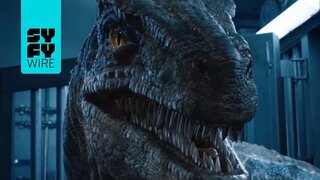Create a free profile to get unlimited access to exclusive videos, sweepstakes, and more!
What Do Picky Tyrannosaur Kids Eat? Researchers Find Baby Dino Preserved with Last Meal
This tiny tyrannosaur has a belly full of dinosaur drumsticks.
Building a theme park of resurrected dinosaurs isn’t as easy as it sounds, and it doesn’t sound that easy. Getting ahold of DNA, repairing the gaps in the sequence, and incubating your baby dinos is only the beginning. The end, of course, plays out in Jurassic World Dominion, streaming now on Peacock. But there are half a hundred steps before that.
Once your baby Tyrannosaur hatches, you’re going to have to feed it, and we don’t exactly know how to do that. Tyrannosaurs go through dramatic physical changes between birth and adulthood, and information about how and what they ate has remained mysterious, until now. A new study published in the journal Science Advances describes an incredibly preserved juvenile tyrannosaur complete with stomach contents containing its last meals.
What Do Baby Tyrannosaurs and Other Dinosaurs Eat?
Tyrannosaurs were a diverse group of predatory theropod dinosaurs which fed on a wide range of large prey animals. Before this specimen was uncovered, paleontologists had never found a Tyrannosaur fossil which included stomach contents, but we’ve been able to infer their feeding habits in other ways.
RELATED: So apparently a baby tyrannosaurs was deceptively adorable, but still deadly
“We know the adults were preying on these very large, plant-eating dinosaurs like horned dinosaurs and duck-billed dinosaurs that traveled in herds. We know that from teeth in the bones or bite marks in the bones, but there has really been no indication of what the juveniles were eating,” study author Darla Zelenitsky told SYFY WIRE.
Adult Tyrannosaurs regularly fed on large horned dinosaurs and herding duck billed dinosaurs, but it’s unlikely that a juvenile would have had the strength needed to take down large prey. Paleontologists suspected that juveniles might have been pack hunting, relying on strength in numbers to take down prey until they were large enough to do it on their own. Others suspected they might have tailed their more massive parents, picking up on leftover scraps. Now, we know that juvenile Tyrannosaurs were well adapted for chasing down fast, small prey animals. We know that because the juvenile Tyrannosaur scientists uncovered had the legs of two smaller dinosaurs in its guts.
A 75-Million-Year-Old Juvenile Tyrannosaur’s Last Meal
The specimen was found in 2009, buried in Alberta’s Dinosaur Provincial Park. It’s a well-known prehistoric ecosystem dated to between 77 and 75 million years ago. People have been collecting dinosaur fossils from the region for more than a century a,nd more than 50 species have been identified there, in addition to turtles, crocodiles, fish, mammals, birds, pterosaurs, plants, and more.
The fossil’s tail is missing but it is otherwise complete and articulated, with the bones largely in their correct positions within the rock matrix. Its age is estimated at between 5 and 7 years, only about midway to the transition point between juvenile and adult, which scientists believe occurred at roughly 11 years of age.
Well-preserved juvenile fossils are rare on their own – their comparatively small bones are more difficult to preserve – but the bonus contents weren’t identified until later. It wasn’t until the bones were taken back to the lab for preparation that researchers noticed tiny toe bones sticking out between the ribs.
“A group meeting took place, and it was decided that the specimen would be flipped over and prepared from the inside-out in order to determine what was present inside the ribcage,” study author Francois Therrien, told SYFY WIRE. “And it is at that time that the legs of two small dinosaurs were discovered where the stomach would have been located.”
RELATED: Tyrannosaurs Ripped Each Other’s Faces Off So They Could Get What They Wanted
Analysis revealed that each of the legs came from separate individuals, both young bird-like dinosaurs called Citipes. Interestingly, only the legs were found with the rest of the animal seemingly discarded.
“Not only did they feed on different species, but the way they processed their food was different," Therrien said. "Whereas adults were more 'indiscriminate' feeders, eating all parts of a megaherbivore carcass, often pulverizing and swallowing bones in the process, young individuals were far more 'surgical' in how they fed. They selectively dissected away the legs of Citipes and swallowed those legs whole without crushing them.”
The dramatic size difference between juvenile and adult Tyrannosaurs was certainly part of why they ate different things, but it wasn’t the only factor. More significant skeletal changes throughout their development probably facilitated the transition from tiny prey to large meals.
"Tyrannosaurs would have hatched from a relatively small egg. The hatchlings would have been small, maybe a few kilograms, and this particular Tyrannosaur reached something like 3,000 kilograms. There are also morphological changes noted in Tyrannosaurs. The younger individuals are, besides being smaller, much more slender, gracile. They had long legs and were built for running. They had narrow skulls, snouts, and narrow blade-like teeth. At some point along their growth to adults, everything becomes more massive and more robust. Their skulls are wider, their teeth are wider, their jaws are more robust. They are just more massive overall,” Zelenitsky said.
In addition to finally revealing how tiny Tyrannosaurs made a living, the stomach contents also represent the most complete Citipes ever found. It’s likely that scientists will be studying this little guy’s lunch for a long time to come. If we ever do build a dino theme park of our own, we’ll at least know how to feed the little monsters.
Catch the thrilling conclusion to John Hammond’s mistake in Jurassic World Dominion, streaming now on Peacock.
































